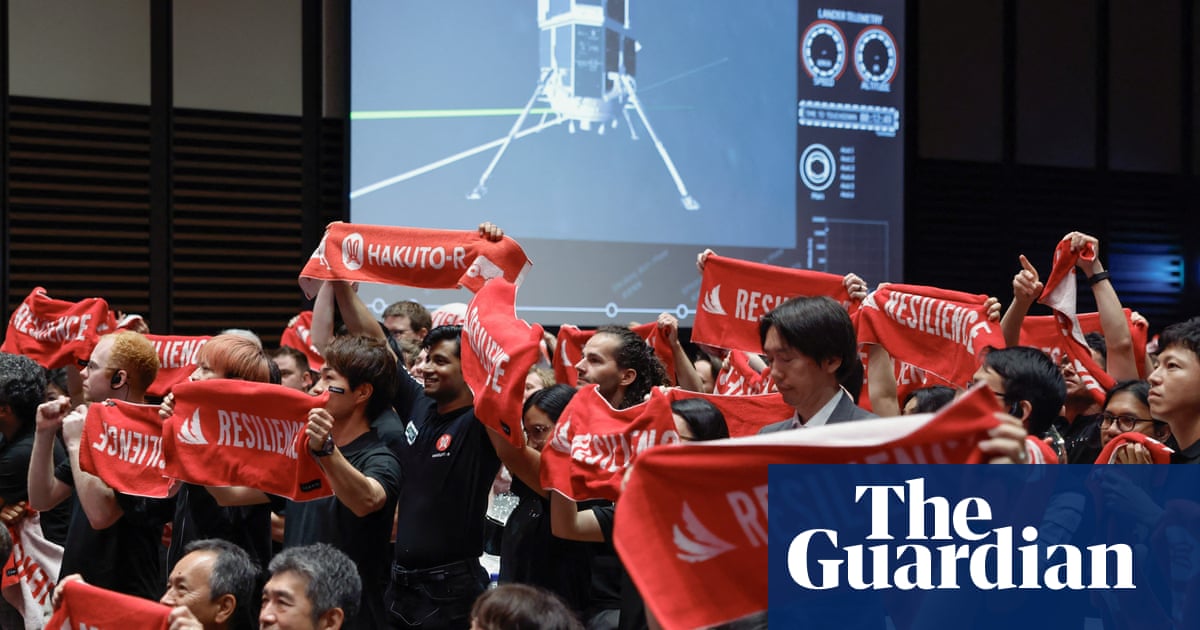An attempt to land a commercially built spacecraft on the surface of the moon looked to have ended in failure on Thursday, two years after its predecessor, launched by the same Japanese company, crashed following an uncontrolled descent.
Resilience, an un-crewed vehicle from the Tokyo companyispace, would have made history as the first non-US commercial lander to make a successful touchdown, scheduled for 3.17pm ET Thursday (4.17am JST Friday) at Mare Frigoris (the Sea of Cold) in the far north of the moon.
But the company’s live stream covering the landing attempt ended almost 30 minutes later, with mission managers unable to establish communication with the craft, and its fate uncertain.
“Mission control center members will continuously attempt to communicate with the lander,” an ispace commentator said immediately before the feed was pulled, promising an update at a press briefing “in a few hours”.
It brought back memories of theApril 2023 failureof ispace’s Hakuto-R Mission 1, when communication with the spacecraft was lost around the scheduled time of landing. It was later established that a software error had led the lander to believe it had already touched down when it was still hurtling towards the lunar surface.
Resiliencelaunched on 15 Januaryfrom Cape Canaveral, Florida, on the same SpaceX Falcon 9 rocket that carried the Blue Ghost lander manufactured by the Texas startup Firefly Aerospace.Blue Ghostfollowed a speedier trajectory to the moon and made its own pioneering landing on 2 March.
The apparent demise of Hakuto-R Mission 2 would be a significant setback for ispace’s Venture Moon initiative that it said would be “laying the groundwork” for an extended human presence on the moon. Ambitious plansinclude a lunar citywith a thousand residents, the first arriving as early as 2040.
It also hopes to eventually accommodate thousands more space tourists for shorter visits.
“Our goal is to build the cislunar economy, one in which the moon and Earth are economically and socially connected,” ispace’s chief executive, Takeshi Hakamada, said in a prepared statement released before Thursday’s landing attempt.
“We view the success of the lunar landing as merely a stepping stone toward that goal. We strongly believe that this endeavor and its long-term success will contribute to making life on Earth sustainable for all humanity.”
Resilience was set to deploy a small, European-built moon rover named Tenacious for a two-week mission. High-definition video footage and telemetry would have been beamed back to Earth for monitoring by the EuropeanSpaceAgency (Esa) and partners.
The rover has a shovel intended to collect soil samples for evaluation as the search for evidence of the presence of life-sustaining water or ice on the moon continues.
Nasa, the US space agency, will pay ispace $5,000 under an agreementsigned in 2020for a chunk of regolith it can study in furtherance of its own plans to land humans back on the moon for the first time since 1972, and ultimately on Mars.
“Tenacious is hopefully a very successful technological achievement, but beyond the technology it’s also a symbol of the future of lunar exploration,” Géraldine Naja, Esa’s director of commercialization, industry and competitiveness, told reporters earlier on Thursday.
“Esa is extremely proud and thrilled to support ispace Mission 2. This is a very good example of how we can support new space actors in Europe [and] commercialization. We are eager to support, eventually, a sustainable European-Japanese presence on the moon.”
The 11lb (5kg) rover was also carrying a more quirky payload: Moonhouse, a model installation created by Swedish artist Mikael Genberg, that would have become the first property on the moon, albeit in miniature form.
The bright red Swedish-style house was to have provided a splash of color against the gray backdrop of the moon’s northern reaches.
“It’s a small house in a vast, empty place, a symbol of belonging, curiosity and vulnerability,” Genberg toldspace.comin an interview published on Thursday.
“I hope it invites people to reflect on our relationship to space, and to recognize the fragility and uniqueness of our own world.”
While the governments of five countries – the US, Russia, China, India and Japan – have successfully landed un-crewed robotic lunar explorers, commercial efforts have seen more failures than successes in recent years.
In addition to the previous ispace flop, two attempts by the Texas company Intuitive Machines (IM), with itsOdysseusandAthenalanders in February 2024 and March 2025 respectively, ended prematurely when both spacecraft toppled over on landing.
Mare Frigoris is a flatter area of the moon, with fewer boulders than the landing sites chosen by IM and Firefly.
Ispace also chose to take its time getting to the moon, with the five-month journey of Resilience during a so-called low-energy transfer allowing the company to thoroughly evaluate its systems and computer programs after blaming a software error for the 2023 crash landing.
A contract with Nasa will see ispace attempting to send a larger rover to the moon on a mission scheduled for 2027.
